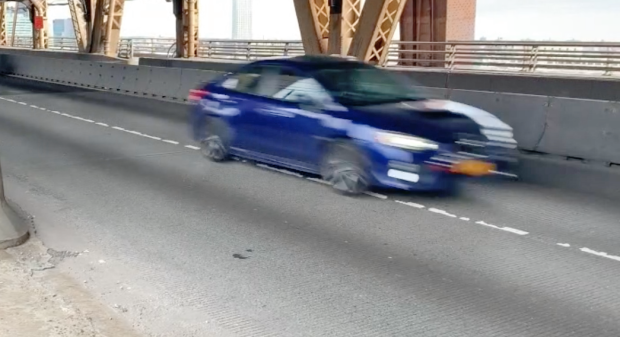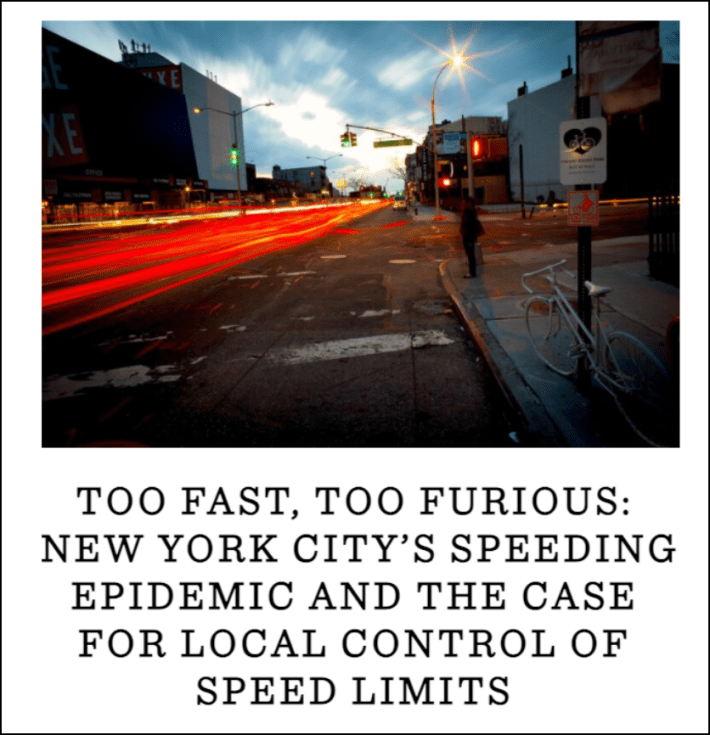

They’re fast — we’re furious.
Seventy percent of New York City drivers were spotted exceeding the posted speed limit — some by more than double — according to a new report that will be issued today by Transportation Alternatives, which hopes the study will create more momentum behind a package of bills in Albany to rein in New York’s reckless drivers.
First, the bad news:
Transportation Alternatives sent teams to roadways in each of the five boroughs to capture — with radar guns — a snapshot of the extent of the well-documented problem of speeding. The topline result: 70 percent of drivers were exceeding the posted speed limit of 25 miles per hour during the group’s observation sessions (which captured the patterns of 1,600 drivers).
Breaking that down:
- Speeding was at its worst on Staten Island, where 94 percent of the drivers were breaking the law when TA observers stood on arterial Slosson Avenue at Martling Avenue in two-hour sessions on May 7 and May 11 (and one driver was traveling 63 MPH, which is 152 percent faster than the speed limit). There are eight schools within one mile of this location, seven of which serve elementary age school children.
- Speeding is also epidemic in Queens, where 73 percent of the drivers were speeding when the radar guns were trained on them on Skillman Avenue at 32nd Place on April 23 and 25. There are 20 schools within one mile of this location, half of which serve pre-kindergarteners and elementary age school children, the group said.
- In the Bronx, 52 percent of drivers sped past 135th Street at Willis Avenue during the two-hour monitoring session on May 21.
- In Brooklyn, 35 percent of drivers were seen speeding on Remsen Avenue at Avenue N in two-hour sessions on May 19 and May 21.
- In Manhattan, 30 percent of drivers were speeding past Ninth and Tenth avenues at West 45th Street in two-hour sessions on May 17 and May 19.
The findings won’t be a surprise to people with eyes … or those who read obscure city Health Department publications. In 2017, the agency revealed that 64 percent of drivers admit that they regularly drove at least 10 miles over the speed limit (Staten Islanders were the most frequent speeders in that survey, too).
“Traffic crashes are a leading cause of preventable injury death in New York City,” the agency reminded, adding that speed is a main contributing factor. (The numbers in that survey are likely lower because it is common for rule-breakers to lie to survey takers about commiting illegal acts.)
The problem with speed is that speed kills: 10 percent of people struck by a driver going 20 miles per hour die from the crash. But that number rises to 40 percent if the car was going 30 MPH and 80 percent once the car is going 40 MPH. In Transportation Alternatives’ speed survey, 17 percent of drivers exceeded the speed limit by 10 MPH or more — meaning faster than 35 miles per hour, or well in the death zone.
Retarding drivers is a key part of Mayor de Blasio’s Vision Zero initiative: When the city’s default speed limit was reduced from 30 to 25 miles per hour in 2014, road fatalities dropped by 10 percent. In just the first six months after that change, total road fatalities dropped 13 percent — and kept dropping by 22 percent over the first full year of the change.
But last year was the bloodiest of de Blasio’s term — almost entirely due to speeding during the pandemic, which increased the force of crashes, so even though there were fewer overall crashes, the ones that did occur were far more severe.
The good news? A package of bills is right now before the state legislature that can arrest the damage done by these drivers.
Central among the bills is the so-called Sammy’s Law, a seemingly common sense bill named after traffic violence victim Sammy Cohen Eckstein that would allow New York City to control its speed limits (perhaps dropping some roads to a reasonable 20 miles per hour or school zones to 15 mph) without requiring approval from upstate lawmakers.
“Without Sammy’s Law, New York City lacks a critical tool to prevent speeding and save lives,” said Amy Cohen, who co-founded of Families for Safe Streets after her 12-year-old son was killed by a speeding driver in Park Slope in 2013. “We need state legislators to pass [the package] so no other New York families face the anguish of burying a child, spouse or parent due to preventable traffic violence.”
The package, which has been dubbed the Crash Victims Rights & Safety Act, also includes:
- Traffic-Crash-Victim Bill of Rights: This bill, meant to mirror the federal Crime Victims’ Rights Act, would boost the rights of family members to get more information about the crashes that killed or injured their loved ones.
- Speed-Safety Camera Improvement: This would allow city speed cameras to operate 24/7 and escalate penalties for extreme repeat offenders.
- Vehicle-Safety Rating: The bill would require the state DOT and Department of Motor Vehicles to create a safety-rating system to assess the risk a motor vehicle poses to people outside the car. In New York City, 25 of the 29 cyclists who were killed in 2019 were killed by drivers of large trucks, buses, SUVs or vans.
- Blood-Alcohol Content: This bill would lower the blood alcohol concentration limit for driving from .08 percent to .05 percent.
- More Room for Cyclists: This bill would create a definition of what a “safe passing distance” is for motorists (at least three feet).
- DMV Pre-Licensing: This would require would-be drivers to get instruction in pedestrian and bicyclist safety as part of normal pre-licensing courses.
Support for Sammy’s Law is widespread, a new Transportation Alternatives poll — also released today – shows.
According to the group’s survey by Emerson College polling, 72 percent of city voters said yes when asked, “Do you support giving New York City local control to lower speed limits on select residential streets?” Only 19 percent opposed such a common-sense law. And 68 percent of New Yorkers said they would “personally like to see the speed limit reduced from 25 to 20 miles per hour on residential streets.” Only 31 percent opposed that.
Such results dovetail with a survey conducted earlier this year by Streetsblog’s parent company, Open Plans, and conducted by Data for Progress. In that survey of 571 registered Democrats, 65 percent of voters (and 72 percent of Hispanic or Latino voters) said affirmatively, “Drivers in my neighborhood need to slow down.” And 72 percent agreed that the city must create “livable streets that prioritize people’s needs and their safety” over “streets that prioritize car traffic and parking.”

“Believe it or not, but Albany has control over the speed limit on New York City streets,” said Transportation Alternatives Deputy Director Marco Conner DiAquoi. “Vision Zero is in crisis, yet state law prevents city officials from lowering the speed limit on roads across the five boroughs. … If state legislators do not pass Sammy’s Law this session, the number of New Yorkers killed and injured in preventable traffic crashes will sadly continue to rise.”








